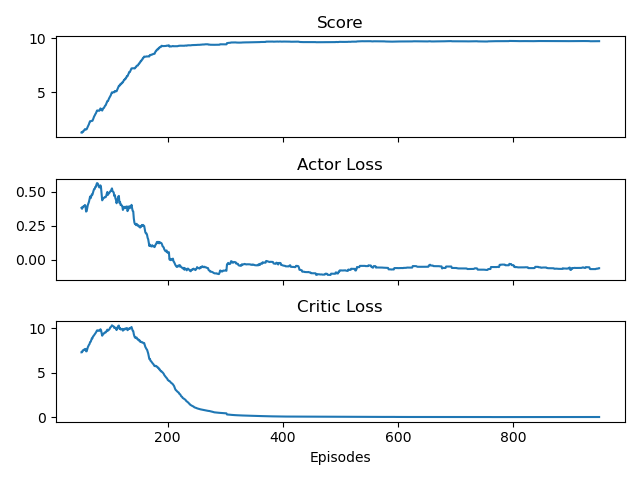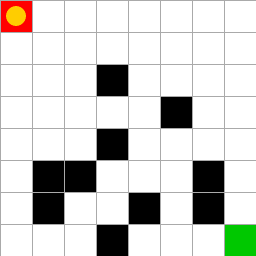This is a fork of damat-le/gym-simplegrid which I've modified for use as part of a training workshop on deep (meta) reinforcement learning.
This part of the workshop will involve running and editing code locally on your own laptop.
(If you don't already have Anaconda or miniconda installed, do that first. You may need to restart your computer before you can use conda from the command line.)
Initialize a conda environment with pytorch and matplotlib 3.5 installed.
conda create -n workshop matplotlib=3.5 pytorch -c pytorch
Activate your new environment
conda activate workshop
Install openAI gym 0.23 and pygame.
pip install gym==0.23 pygame
Create a directory where you want save the workshop materials. From within that directory, clone this github repository.
git clone https://github.com/thompsonj/gym-simplegrid.git
Then, install simplegrid
cd gym-simplegrid
pip install -e .To make sure everything is setup correctly, run
python train.py --render
This should bring up a window where you can see the agent moving in the default environment (a simple room with a goal). However, rendering makes training much slower, so when you want training to complete quickly, simply remove the --render flag.
python train.py
On my laptop this takes 15 seconds to train on 1000 episodes. It should save some learning curves that look something like this:
Once you have your conda environment setup and everything installed, checkout the exercises in exercises.md
The original README follows below:
SimpleGrid is a super simple gridworld environment for OpenAI gym. It is easy to use and customise and it is intended to offer an environment for quick testing and prototyping different RL algorithms.
It is also efficient, lightweight and has few dependencies (gym, numpy, matplotlib).
SimpleGrid involves navigating a grid from Start(S) (red tile) to Goal(G) (green tile) without colliding with any Wall(W) (black tiles) by walking over the Empty(E) (white tiles) cells. The yellow circle denotes the agent's current position.
Optionally, it is possible to introduce a noise in the environment that makes the agent move in a random direction that can be different than the desired one.
To install SimpleGrid, you can either use pip
pip install gym-simplegridor you can clone the repository and run an editable installation
git clone https://github.com/damat-le/gym-simplegrid.git
cd gym-simplegrid
pip install -e .Please use this bibtex if you want to cite this repository in your publications:
@misc{gym_simplegrid,
author = {Leo D'Amato},
title = {Simple Gridworld Environment for OpenAI Gym},
year = {2022},
publisher = {GitHub},
journal = {GitHub repository},
howpublished = {\url{https://github.com/damat-le/gym-simplegrid}},
}Basic usage options:
import gym
import gym_simplegrid
# Load the default 8x8 map
env = gym.make('SimpleGrid-8x8-v0')
# Load the default 4x4 map
env = gym.make('SimpleGrid-4x4-v0')
# Load a random map
env = gym.make('SimpleGrid-v0')
# Load a custom map with multiple starting states
# At the beginning of each episode a new starting state will be sampled
my_desc = [
"SEEEEEES",
"EEESEEES",
"WEEWEEEE",
"EEEEEWEG",
]
env = gym.make('SimpleGrid-v0', desc=my_desc)
# Set custom rewards and introduce noise
# The agent will move in the intended direction with probability 1-p_noise
my_reward_map = {
b'E': -1.0,
b'S': -0.0,
b'W': -5.0,
b'G': 5.0,
}
env = gym.make('SimpleGrid-8x8-v0', reward_map=my_reward_map, p_noise=.4)Example with rendering:
import gym
import gym_simplegrid
env = gym.make('SimpleGrid-8x8-v0')
observation = env.reset()
T = 50
for _ in range(T):
action = env.action_space.sample()
env.render()
observation, reward, done, info = env.step(action)
if done:
observation = env.reset()
env.close()The action space is gym.spaces.Discrete(4). An action is a int number and represents a direction according to the following scheme:
- 0: LEFT
- 1: DOWN
- 2: RIGHT
- 3: UP
The observation is a value representing the agent's current position as
current_row * ncols + current_col (where both the row and col start at 0).
For example, the point in position (2,3) in a 4x5 map corresponds to state 13 (= 2 * 5 + 3).
The number of possible observations is dependent on the size of the map.
For example, the 4x4 map has 16 possible observations.
It is possible to customize the rewards for each state by passing a custom reward map through the argument reward_map.
The default reward schedule is:
- goal(G): +1
- wall(W): -1
- empty(E): 0
- start(S): 0
The default frame rate is 5 FPS. It is possible to change it through env.fps after instantiating the environment.
To properly render the environment, remember that the point (x,y) in the desc matrix corresponds to the point (y,x) in the rendered matrix. This is because the rendering code works in terms of width and height while the computation in the environment is done using x and y coordinates. You don't have to worry about this unless you play with the environment's internals.
v0: Initial versions release (1.0.0)

